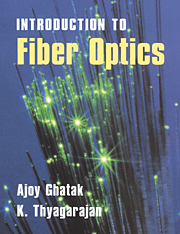Book contents
- Frontmatter
- Contents
- Preface
- Acknowledgments
- Abbreviations
- 1 Introduction: The fiber optics revolution
- 2 Basic optics
- 3 Basic characteristics of the optical fiber
- 4 Ray paths and pulse dispersion in planar optical waveguides
- 5 Pulse dispersion in graded index optical fibers
- 6 Material dispersion
- 7 Modes in planar waveguides
- 8 Propagation characteristics of a step index fiber
- 9 Propagation characteristics of graded index fibers
- 10 Waveguide dispersion and design considerations
- 11 Sources for optical fiber communication
- 12 Detectors for optical fiber communication
- 13 Design considerations of a fiber optic communication system
- 14 Optical fiber amplifiers
- 15 Dispersion compensation and chirping phenomenon
- 16 Optical solitons
- 17 Single-mode fiber optic components
- 18 Single-mode optical fiber sensors
- 19 Measurement methods in optical fibers: I
- 20 Measurement methods in optical fibers: II
- 21 Periodic interactions in waveguides
- 22 The ray equation in cartesian coordinates and its solutions
- 23 Ray paths and their classification in optical fibers
- 24 Leaky modes
- Appendix A Solution of the scalar wave equation for an infinite square law medium
- Appendix B The far-field pattern
- Appendix C WKB analysis of multimode fibers
- Appendix D Gaussian envelope approximation
- Appendix E Coupled-mode equations
- Appendix F Derivation of coupled-mode equation for periodic coupling
- Appendix G Leakage loss in optical waveguides
- References
- Index
13 - Design considerations of a fiber optic communication system
Published online by Cambridge University Press: 05 June 2012
- Frontmatter
- Contents
- Preface
- Acknowledgments
- Abbreviations
- 1 Introduction: The fiber optics revolution
- 2 Basic optics
- 3 Basic characteristics of the optical fiber
- 4 Ray paths and pulse dispersion in planar optical waveguides
- 5 Pulse dispersion in graded index optical fibers
- 6 Material dispersion
- 7 Modes in planar waveguides
- 8 Propagation characteristics of a step index fiber
- 9 Propagation characteristics of graded index fibers
- 10 Waveguide dispersion and design considerations
- 11 Sources for optical fiber communication
- 12 Detectors for optical fiber communication
- 13 Design considerations of a fiber optic communication system
- 14 Optical fiber amplifiers
- 15 Dispersion compensation and chirping phenomenon
- 16 Optical solitons
- 17 Single-mode fiber optic components
- 18 Single-mode optical fiber sensors
- 19 Measurement methods in optical fibers: I
- 20 Measurement methods in optical fibers: II
- 21 Periodic interactions in waveguides
- 22 The ray equation in cartesian coordinates and its solutions
- 23 Ray paths and their classification in optical fibers
- 24 Leaky modes
- Appendix A Solution of the scalar wave equation for an infinite square law medium
- Appendix B The far-field pattern
- Appendix C WKB analysis of multimode fibers
- Appendix D Gaussian envelope approximation
- Appendix E Coupled-mode equations
- Appendix F Derivation of coupled-mode equation for periodic coupling
- Appendix G Leakage loss in optical waveguides
- References
- Index
Summary
Introduction
In the preceding chapters we discussed the characteristics of optical fibers, optical sources, and optical detectors. These form the three basic units of any optical fiber communication system. In this chapter we discuss how these basic elements can be put together to build a simple point-to-point optical fiber communication link.
Let us assume that we need to transmit information between two points (see Figure 13.1). The separation between these points could range anywhere from less than a kilometer in the case of computer data links to several thousands of kilometers, for instance, in transoceanic links. In all such links, there would be a transmitter that could be either an LED or a laser diode, the transmission path consisting of optical fibers that could be either multimode or singlemode fibers, and the optical receiver that could be a PIN or APD followed by the detection electronics. The choice of the components would depend on the distance as well as on the bit rate. When the separation between the points is greater than about 50–100 km, then because of attenuation in the link or pulse dispersion, it becomes necessary to use regenerators that consist of a receiver–transmitter combination. These regenerators detect the pulse stream before the power becomes too low or the pulses become unresolvable and retime, reshape, and regenerate (and, hence, the name 3R repeater) a new set of optical pulses to be transmitted over the next part of the link. For links that are limited by loss rather than by dispersion, one can use optical amplifiers in place of regenerators.
- Type
- Chapter
- Information
- An Introduction to Fiber Optics , pp. 249 - 280Publisher: Cambridge University PressPrint publication year: 1998



